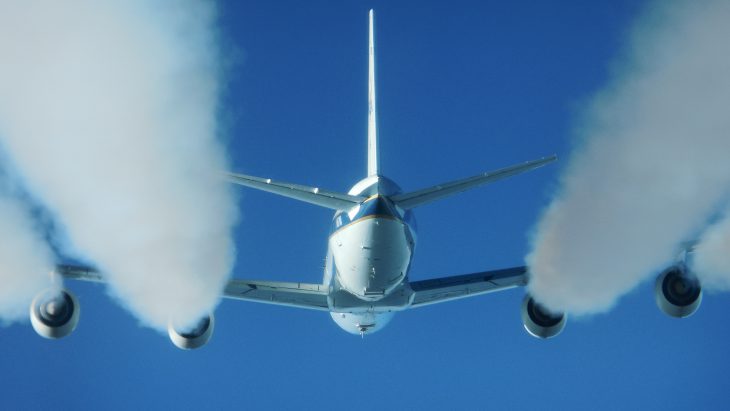When everyday life came to a sudden halt in March 2020 due to the Covid-19 pandemic, many wondered what the impact would be on climate. One major change was the drastic reduction in airplane travel world wide as countries encouraged their residents to limit non-essential travel. A recent study looked directly at the impact this reduced air travel had on climate, by studying changes in ice crystals in cirrus clouds.
Cirrus clouds are thin and wispy and composed primarily of ice crystals. The size, shape, and density of these ice crystals determines how much energy from earth’s surface and atmosphere will be reflected or absorbed. This is referred to as the cloud’s radiative properties. When ice crystals trap heat, the temperature beneath the clouds increases. When the ice crystals are smaller, they reflect that energy and do not contribute to rising temperatures.
Why does this matter for airplanes? Previous studies have shown that soot particles in the exhaust of airplanes increases the density and size of cirrus cloud ice crystals, and therefore increases the cloud’s radiative properties. Less soot means less reflection.
It was shown previously that global flight mileage and therefore aircraft soot emission was increasing 5% per year between 2013-2019. Flight mileage was expected to continue increasing at this rate, before the pandemic.
Scientists in the US, Hong Kong, and China wanted to test their hypothesis that fewer flights would impact cirrus clouds. First, they gathered flight information between January-May in 2019 and 2020 from a commercial database, FlightRadar24. They found a 0.3% decrease in global flight mileage in January and February 2020 compared to those same months in 2019. This decrease corresponded with fewer flights in and out of China during those months.
There was a more drastic decrease of 26% in global flight mileage in March 2020 as the pandemic slowed travel in Europe and North America. Then, they noticed an even greater decrease of 73% in April and May 2020 compared to those same months in 2019. Assuming shortest routes were taken, they used this flight mileage data to calculate the amount of soot emitted from the planes during these time periods.
The scientists then looked at ice crystal concentration data in clouds collected by satellite during these same time periods. They used data gathered by the Cloud-Aerosol Lidar and Infrared Pathfinder Satellite Observations, CALIPSO for short, a satellite operated jointly by NASA (USA) and CNES (France). The scientists divided the earth up into four horizontal, or latitude, bands and looked at the ice crystal data in these four bands for January to May in 2018, 2019, and 2020.
There was no significant change in ice concentration in January-February 2020 compared to those same months in 2018 and 2019. However, the satellite did measure an increase in ice crystal concentration for April-May 2020 for the latitude band over China and downwind of Western Europe. The scientists performed a statistical analysis on this data and confirmed the increase was significant at a >95% level, meaning the observed change was unlikely to be due to chance.
They did not see a significant difference in ice crystal concentration over and downwind of North America. This is likely because the type of ice formation that occurs from aircraft soot is most likely over mountains. The terrain downwind of Europe is mountainous while the area downwind of North American is the Atlantic ocean.
The scientists used computer models to simulate the observed increase in ice crystal concentration over China and downwind of Europe during April-May 2020, and found it predicted a close but slightly higher ice crystal concentration than what was collected by satellite. The scientists hypothesize that the satellite could have missed some freezing events as it only passes by a single location once every 16 days.
They then used this model to predict what the impact on cirrus clouds would be if the reduced number of flights were to continue for the next five years. This showed an overall increase in ice crystal concentration on many regions of Earth, most notably northern Eurasia and north Atlantic Ocean.
This increase in ice concentration means the clouds would be more likely to reflect heat away from the Earth and not contribute to rising temperatures. The scientists in this study did acknowledge that their modeling had some uncertainties and more work needs to be done to confirm these findings.
The reduction of flights during the COVID-19 pandemic appears to have led to an increase in the ice crystal concentration in cirrus clouds. Modeling suggests that if this trend continues, these cirrus clouds would continue to reflect heat radiation away from the Earth rather than retain it. However, it is unlikely that air traffic will remain as low as it was in April-May 2020 when the pandemic first began.


